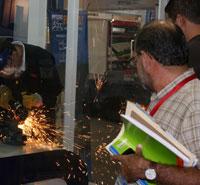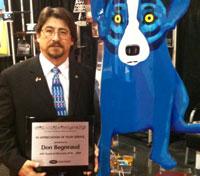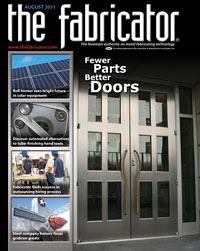Editor-in-Chief
- FMA
- The Fabricator
- FABTECH
- Canadian Metalworking
Categories
- Additive Manufacturing
- Aluminum Welding
- Arc Welding
- Assembly and Joining
- Automation and Robotics
- Bending and Forming
- Consumables
- Cutting and Weld Prep
- Electric Vehicles
- En Español
- Finishing
- Hydroforming
- Laser Cutting
- Laser Welding
- Machining
- Manufacturing Software
- Materials Handling
- Metals/Materials
- Oxyfuel Cutting
- Plasma Cutting
- Power Tools
- Punching and Other Holemaking
- Roll Forming
- Safety
- Sawing
- Shearing
- Shop Management
- Testing and Measuring
- Tube and Pipe Fabrication
- Tube and Pipe Production
- Waterjet Cutting
Industry Directory
Webcasts
Podcasts
FAB 40
Advertise
Subscribe
Account Login
Search
Finding customers at trade shows
Showing up with a booth is not a suitable plan for success
- By Dan Davis
- August 1, 2011
- Article
- Shop Management

Figure 1: An industry event such as FABTECH Mexico provides an opportunity for metal fabricators not only to meet new customers and contacts, but renew old friendships that have been made over the years.
Have you ever seen this guy at a tradeshow? He’s sitting in the back of his little booth late in the afternoon, trying to read his folded-up newspaper and eat a huge burrito without spilling it on his golf shirt that bears the name of the company on the banner that’s hanging on the back wall. The company name has “Metal“ in it, but you are not sure what they do because the booth has no equipment or metal parts in it, just a bunch of brochures with the same company logo and some sparks from some sort of manufacturing operation. To be fair, that guy also had some pens on the shelving unit that separates him from the tradeshow attendees walking the aisle, but someone swiped them when he left his booth to go look for a restroom earlier in the morning.
Remember him? Well, don’t be that guy. He’s not doing anything except consuming calories, losing pens, and wasting his employer’s valuable money.
To attract customers at tradeshows, metal fabricators need to put forth as much effort in planning as they would in preparing for a very important job. They need to set forth goals and discuss how they will be attained before showing up at the event, and they need to create an open and inviting environment within the booth during the event. After the tradeshow, fabricators need to be diligent in following up.
Just showing up is not going to cut it if a company is going to maximize its tradeshow investment. The following tips can help transform this marketing cost into a promising sales opportunity.
Prepare Before the Tradeshow
“People who attend tradeshows are interested in finding out what is new in the industry. What are the new products, and what are the new opportunities? So they are seeking education,” said David Zahn, a business owner and consultant.
A survey of attendees at the 2010 FABTECH® in Atlanta revealed this to be true. Of the more than 800 respondents to the survey, 86 percent reported they were attending to evaluate new products and technology, and 55 percent said they wanted to see new equipment in action.
The attendees aren’t rushing their information-gathering either. In that same survey, 36 percent said they spent six to nine hours on the show floor, and 45 percent spent more than 12 hours.
In short, tradeshows typically attract people interested in learning, and it’s up to the exhibitors to provide that education.
That leads to the main question metal fabricators should ask themselves: Which tradeshows make the most sense for my company? For fabricators, that choice usually entails an industry event such as FABTECH (see Figure 1) or a regional event, such as the Design2Part shows, where OEMs might be looking for outsourcing partners.
Don Begneaud, owner and president of metal fabricating firm BEGNEAUD Manufacturing, Lafayette, La., likes to attend tradeshows and prepares to introduce his company to as many people as possible.

Figure 2: Exhibitors must display those products that will be of interest to the tradeshow attendees. It helps if those exhibitors can position their booths in areas where foot traffic is consistent—near restaurants, restrooms, or larger exhibitors.
“My idea is to do two things: Be out there for those who have never heard of us … and pick up new accounts, which might be other exhibitors,” he said.
Begneaud recounted a story of a small exhibition in Baton Rouge, La., where he started chatting with his next-door booth proprietor, a maker of industrial ball valves, and found out that the company had a ball valve that could be controlled remotely. Well, the actuator that turned that ball valve on or off, after the remotely delivered command was received, required a bracket to connect it to the ball valve. Several weeks later, Begneaud was making that bracket.
Zahn said that approach, knowing exactly what kind of attendees and exhibitors will be there and the precise location of the booth, is an absolute requirement for those serious about attracting customers (see Figure 2). A metal fabricator may not require tons of preparation if it has participated in the trade event in the past, but if it is thinking about attending a new or niche tradeshow, it will need to do some research. Attending something as large as the Specialty Equipment Market Association automobile aftermarket products show or as small as the Hearth, Patio & Barbecue Expo still calls for a similar need to conduct research. A metal fabricator simply can’t show up and exhibit, expecting people to know what fabricating is; the exhibitor needs to explain to manufacturers who might be walking the show not only what type of metal fabricating it does, but why work should be outsourced to it.
“You don’t use the same sales presentation for every channel or industry that you sell into. Similarly, you wouldn’t market in tradeshows the same way,” Zahn said.
The sales message for the tradeshow, as a result, influences the graphics and products in the booth (see Figure 3). Begneaud said at an industry event such as FABTECH that he chooses to put his “shotgun” video message, which describes his company and overall capabilities, on a large monitor and smaller “rifle” video messages, each explaining a manufacturing capability in-depth, on portable DVD players spread throughout the booth. The approach for a smaller tradeshow might call for using a video and graphics that specifically cover the manufacturing capability that would be of interest to that show’s attendees—such as tube bending at an off-road vehicle show.
The “mission” for a particular tradeshow also affects special appearances in the booth. For example, several FABTECH exhibitors in recent years invited reality television stars such as the Teutuls from Orange County Choppers or the Howe brothers from “Black Ops Brothers,” all of whom have metal fabricating experience. In other instances, exhibitors might showcase an intricately designed metal product, such as a custom-built motorcycle or a piece of art.
Zahn said inviting a guest or having some sort of other attraction with little connection to the tradeshow is a gamble not worth taking. The show attendees likely will remember the attraction, not the exhibitor.
“It doesn’t make sense to have a WWE champion sitting there bare-chested. What does that do for me?” Zahn asked.
To keep the whole exercise of preparing and exhibiting at a tradeshow tied to the sales effort, Zahn recommended that tradeshow responsibilities rest with the sales department, especially for those companies that do not have a person or group dedicated to tradeshow organization and logistics. After all, the salespeople should be the ones manning the booth, as they are experienced in gathering details from prospective clients rather than just pushing product or service features on those who walk by.
Be Attentive While at the Tradeshow
With sales being the ultimate goal, trade booth organizers obviously want an open booth design with the salespeople near the aisles. Tables or displays that separate the booth from the visitors are not recommended. Technical experts are welcomed, but only when they are called upon.

Figure 3: Don Begneaud of BEGNEAUD Manufacturing poses with his plaque, which recognized his service to the Fabricators & Manufacturers Association’s Nuts, Bolts & Thingamajigs Foundation, and his giant metal replica of artist George Rodrigue’s famous blue dog. Begneaud said the blue dog fabrication is a great focus piece for his tradeshow booth because it draws people into conversations and shows off his shop’s precision manufacturing talents.
“I want my salespeople in the booth. I might want to have a senior executive, so if the situation should arise, you can introduce one executive to another CEO type waiting on the show floor. That’s always productive,” Zahn said. “In terms of product manager, engineer, brand manager, technical experts—[they can be in the booth] only if they have been properly trained in how to talk to a prospect.”
Because a salesperson rarely has time to walk the tradeshow attendee through the entire sales process, as he or she might on an office visit, the communication approach varies slightly at a trade event, according to Zahn.
“So the job really is to first qualify, determine if the person you are speaking with is the decision-maker and what criteria will be applied to them to help make the decision. Also, you need to find out when they intend to make this decision,” he said. “Then the best thing to do is follow up with them away from the tradeshow floor.”
Begneaud said he aggressively tries to meet all sorts of people during tradeshows, collecting business cards, jotting down information if the person doesn’t have a business card, and even taking pictures to associate a face with the initial introduction. He wants to not only improve his chances of meeting potential customers, but also act as a conduit for other people to connect—even if it has nothing to do with metal fabricating. Begneaud said that dedication to helping those he’s in a position to help creates something much stronger than a simple Rolodex® of names and phone numbers.
“I want to build not just a database, but a working network with one another,” he said.
It’s that type of energy that is necessary for people wanting to stay engaged in the mission of meeting prospective customers in the tradeshow aisle.
“I would have relatively frequent booth shift changes,” Zahn said. “If you have enough people that you could do it for two hours and then shift—fabulous. But once you get past four hours, a person’s stamina can only go so far and it begins to show.”
Be Aggressive in Following up After the Tradeshow
Begneaud makes the most of following up on his contacts at tradeshows by using modern technology. By the time the show has ended, he said he has already sent numerous messages back to the office from his smart phone, directing his employees to follow up with his new contacts. When he returns to the office, he ensures that the business cards are scanned in and any additional information that he jotted down on the cards—about potential business or how he might be able to help that person with a reference—is input as well.
That urgency is important because leads do get lost sometimes. As amazing as that sounds, companies that don’t make a priority of immediate follow-up can make the mistake of never following up at all.
Zahn said that leads should be fed as soon as possible to those in sales who are responsible for reaching out to customers. The leads also should be organized according to the original tradeshow goal; for instance, if the plan were to concentrate on larger sales, those should be contacted first.
So is a tradeshow a marketing cost or an investment in sales development? The answer is determined by the company’s attitude.
“Those companies that view it as a cost are not going to succeed as well,” Zahn said. “If they view it as an investment, where else could they have people with their wallets out walking up to you.”
Referring back to the survey of attendees at the 2010 FABTECH in Atlanta, 49 percent declared it “extremely” important that they review technologies and equipment in person before making a purchasing decision. Another 39 percent said it was “moderately” important.
People attend tradeshows for a specific reason. It’s up to the exhibiting metal fabricator to turn the information-collection process into a sales opportunity.
About the Author

Dan Davis
2135 Point Blvd.
Elgin, IL 60123
815-227-8281
Dan Davis is editor-in-chief of The Fabricator, the industry's most widely circulated metal fabricating magazine, and its sister publications, The Tube & Pipe Journal and The Welder. He has been with the publications since April 2002.
Related Companies
subscribe now

The Fabricator is North America's leading magazine for the metal forming and fabricating industry. The magazine delivers the news, technical articles, and case histories that enable fabricators to do their jobs more efficiently. The Fabricator has served the industry since 1970.
start your free subscription- Stay connected from anywhere

Easily access valuable industry resources now with full access to the digital edition of The Fabricator.

Easily access valuable industry resources now with full access to the digital edition of The Welder.

Easily access valuable industry resources now with full access to the digital edition of The Tube and Pipe Journal.
- Podcasting
- Podcast:
- The Fabricator Podcast
- Published:
- 05/07/2024
- Running Time:
- 67:38
Patrick Brunken, VP of Addison Machine Engineering, joins The Fabricator Podcast to talk about the tube and pipe...
- Trending Articles
How laser and TIG welding coexist in the modern job shop

Young fabricators ready to step forward at family shop

Material handling automation moves forward at MODEX

A deep dive into a bleeding-edge automation strategy in metal fabrication

BZI opens Iron Depot store in Utah

- Industry Events
Laser Welding Certificate Course
- May 7 - August 6, 2024
- Farmington Hills, IL
World-Class Roll Forming Workshop
- June 5 - 6, 2024
- Louisville, KY
Advanced Laser Application Workshop
- June 25 - 27, 2024
- Novi, MI
Precision Press Brake Certificate Course
- July 31 - August 1, 2024
- Elgin,


























